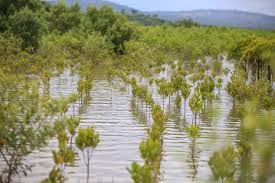

Mangroves /File
A marine scientist has called for the expansion of the area under carbon credits along the Coast, saying it has had positive outcomes to environment and communities.
Kenya Marine and Fisheries Research Institute (KMFRI) chief scientist Dr James Kairo said a huge portion of Kenya’s water is underutilised.
“We recently became aware of benefits associated with the blue economy and we have included ocean climate action in our Nationally Determined Contributions (NDCs),” he said.
Kairo was among scientists that made presentations at the Second International Wildlife Scientific Conference at Lake Naivasha Resort.
He said before expansion, Mikoko Pamoja covered 117. 4 hectares (290 acres) while Vanga Blue Forest covered 460 hectares (1,136 acres).
Mikoko Pamoja has since been expanded to cover 300 hectares (741 acres) while Vanga Blue Forest covers 800 hectares (1,976 acres).
He said the Mikoko Pamoja project before expansion helped remove 2,500 tonnes of carbon dioxide while the Vanga blue Forest helped remove 5,500 tonnes of carbon dioxide.
After the expansion, Mikoko Pamoja is helping to remove 7,000 tonnes of carbon while Vanga Blue Forest is helping remove 8,700 tonnes of carbon dioxide.
Kairo said before expansion, Mikoko Pamoja used to generate $16,000 (Sh2 million) in terms of annual revenue while Vanga Blue Forest used to generate $47,000 (Sh6 million).
Annual community development funds before expansion of Mikoko Pamoja was $3,000 (Sh387,679) while for Vanga Blue Forest was $14,000 (Sh1.8 million).
Following the expansion, Mikoko Pamoja generates an annual revenue of $44,800 (Sh5.8 million) while Vanga Blue Forest generates $81,000 (Sh10 million).
Community development funds for Mikoko Pamoja now stands at $13,800 (Sh1.8 million) while for Vanga Blue Forest is $28,000 (Sh3.6 million).
“Blue carbon projects are transforming lives in Kenya as all carbon credits are owned by the community,” Kairo said.
He said each credit is equal to one tonne of avoided, reduced or removed carbon.
Kairo said blue carbon projects are triple win to climate, community and biodiversity.
He said the tools and capacity for expanding Mikoko Pamoja and Vanga Blue Forests exists.
“There is need to enhance understanding at all levels of the true value of blue carbon ecosystems and need to protect them for climate, community and biodiversity,” Kairo said.
Mikoko Pamoja is a pioneering community-led initiative focused on mangrove conservation and restoration in Gazi Bay, Kenya.
It is the first project of its kind globally to fund conservation through the sale of carbon credits.
Vanga Blue Forest has enabled the protection of 460 hectares of mangroves and community development projects supporting the livelihoods of nearly 9,000 people in three villages: Vanga, Jimbo, and Kiwegu.
Following the recognition of the success of Mikoko Pamoja over the years in environmental protection and community development through conserving their mangroves, the Vanga community came together to protect their forest in the same way.
Mangroves help shield coastlines from erosion and storms, provide vital habitats for marine species and capture large amounts of carbon, helping fight climate change
Kairo said due to their importance, oceans are now helping countries fight the impact of climate change by absorbing 97 per cent of the heat.
He said mangrove ecosystems, for instance, are crucial in the war against climate change and as such, they have a role to play in country’s NDCs.
He said there are 60,000 hectares (148,263 acres) of mangroves in the country.
NDCs embody efforts by each country to reduce national emissions and adapt to the impacts of climate change.
They are submitted every five years to the United Nations Framework Convention on Climate Change (UNFCCC) secretariat.
Kenya plans to reduce its greenhouse gas emissions by 35 per cent by 2035.















